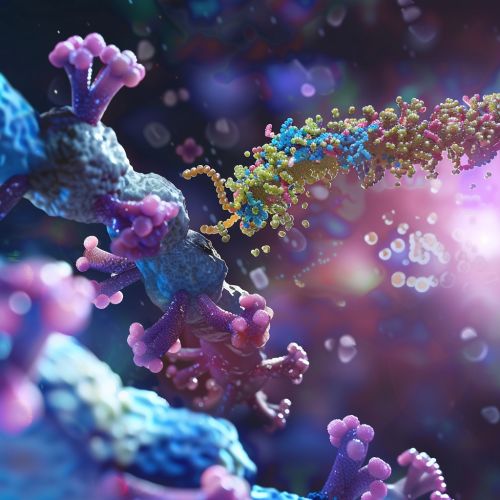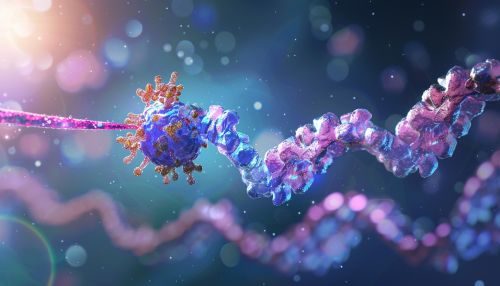Signal Peptides: Difference between revisions
(Created page with "== Introduction == Signal peptides, also known as signal sequences, are short peptides present at the N-terminus of the majority of newly synthesized proteins that are destined towards the secretory pathway. These peptides play a crucial role in directing the nascent protein to the endoplasmic reticulum (ER) in eukaryotic cells or to the plasma membrane in prokaryotic cells. The signal peptide is typically cleaved off by a signal peptidase after the protein has been tran...") |
No edit summary |
||
| Line 5: | Line 5: | ||
Signal peptides are usually 15-30 amino acids long and consist of three distinct regions: a positively charged N-terminal region, a central hydrophobic core, and a polar C-terminal region. The N-terminal region often contains one or more positively charged residues, which are thought to interact with the negatively charged phospholipid head groups of the membrane. The central hydrophobic core is essential for the insertion of the peptide into the lipid bilayer, and the C-terminal region contains the cleavage site for signal peptidase. | Signal peptides are usually 15-30 amino acids long and consist of three distinct regions: a positively charged N-terminal region, a central hydrophobic core, and a polar C-terminal region. The N-terminal region often contains one or more positively charged residues, which are thought to interact with the negatively charged phospholipid head groups of the membrane. The central hydrophobic core is essential for the insertion of the peptide into the lipid bilayer, and the C-terminal region contains the cleavage site for signal peptidase. | ||
[[Image:Detail-93011.jpg|thumb|center|Illustration of a signal peptide interacting with a membrane-bound ribosome.|class=only_on_mobile]] | |||
[[Image:Detail-93012.jpg|thumb|center|Illustration of a signal peptide interacting with a membrane-bound ribosome.|class=only_on_desktop]] | |||
== Mechanism of Action == | == Mechanism of Action == | ||
Latest revision as of 21:35, 21 June 2024
Introduction
Signal peptides, also known as signal sequences, are short peptides present at the N-terminus of the majority of newly synthesized proteins that are destined towards the secretory pathway. These peptides play a crucial role in directing the nascent protein to the endoplasmic reticulum (ER) in eukaryotic cells or to the plasma membrane in prokaryotic cells. The signal peptide is typically cleaved off by a signal peptidase after the protein has been translocated.
Structure and Characteristics
Signal peptides are usually 15-30 amino acids long and consist of three distinct regions: a positively charged N-terminal region, a central hydrophobic core, and a polar C-terminal region. The N-terminal region often contains one or more positively charged residues, which are thought to interact with the negatively charged phospholipid head groups of the membrane. The central hydrophobic core is essential for the insertion of the peptide into the lipid bilayer, and the C-terminal region contains the cleavage site for signal peptidase.


Mechanism of Action
Signal Recognition Particle (SRP)
The signal peptide is recognized by the signal recognition particle (SRP), a ribonucleoprotein complex that halts translation temporarily and directs the ribosome-nascent chain complex to the ER membrane in eukaryotes or the plasma membrane in prokaryotes. The SRP binds to the signal peptide as it emerges from the ribosome, forming a complex that interacts with the SRP receptor on the target membrane.
Translocation
Upon docking at the ER membrane, the SRP-ribosome complex is transferred to the translocon, a protein-conducting channel. The SRP is released, and translation resumes with the nascent polypeptide being threaded through the translocon into the ER lumen or membrane. In prokaryotes, the process is similar, with the translocon located in the plasma membrane.
Signal Peptidase Cleavage
Once the nascent protein is translocated, the signal peptide is cleaved by signal peptidase, an enzyme located in the ER membrane. This cleavage releases the mature protein into the ER lumen or integrates it into the membrane, depending on the protein's final destination.
Functional Significance
Signal peptides are essential for the proper localization and function of proteins within the cell. They ensure that proteins are directed to the correct cellular compartments, which is critical for maintaining cellular organization and function. Mislocalization of proteins due to defective signal peptides can lead to various diseases, including neurodegenerative disorders and cancer.
Evolutionary Perspective
Signal peptides are highly conserved across different species, indicating their fundamental role in cellular processes. The basic structure and function of signal peptides have been preserved throughout evolution, although specific sequences may vary among different organisms and protein types.
Applications in Biotechnology
Signal peptides have been harnessed in biotechnology for the production of recombinant proteins. By attaching a signal peptide to a protein of interest, researchers can direct the protein to the secretory pathway, facilitating its purification and increasing its yield. This technique is widely used in the pharmaceutical industry for the production of therapeutic proteins.
See Also
- Endoplasmic Reticulum
- Signal Recognition Particle
- Protein Translocation
- Signal Peptidase
- Secretory Pathway
